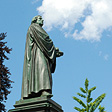HALLOREN CHOCOLATE MUSEUM - HALLE (SAALE)
Chocolate Bunnies and Socialism to Charlie’s Chocolate Factory
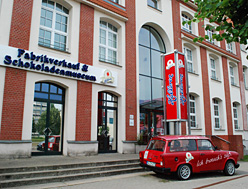 Halloren is the oldest operating chocolate factory of Germany, founded in 1804 in the town of Halle (Saale) in Saxony, not too far from Berlin. They are best known for their Original Halloren Kugeln (globes), a round ball of soft filled chocolate. A treat for kids in the former GDR Germany since the 1950s, Halloren chocolate is not that familiar in the west as the company was behind the iron curtain until German reuninification, but in its revitalised form is one of the most successful traditional chocolate factories in Europe.
Halloren is the oldest operating chocolate factory of Germany, founded in 1804 in the town of Halle (Saale) in Saxony, not too far from Berlin. They are best known for their Original Halloren Kugeln (globes), a round ball of soft filled chocolate. A treat for kids in the former GDR Germany since the 1950s, Halloren chocolate is not that familiar in the west as the company was behind the iron curtain until German reuninification, but in its revitalised form is one of the most successful traditional chocolate factories in Europe.
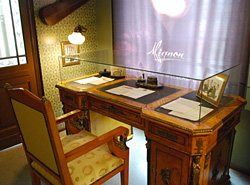 The company was founded in 1804 by Friedrich August Miethe, who first opened a confection and sweet cake bakery in Halle, then started making his own chocolates. In 1851, an entrepreneur confectioner, Friedrich David took over the business and renamed the company, Friedrich David & Sons, launching the chocolate brand Mignon. In 1912 the company was the first to use delivery cars for its product and in the 1920s became known for its Pralines in elegant designer packaging, chocolate tins and chocolate in forms, like the chocolate rabbits we’ve come to think of at Easter time. But the next few decades took a toll.
The company was founded in 1804 by Friedrich August Miethe, who first opened a confection and sweet cake bakery in Halle, then started making his own chocolates. In 1851, an entrepreneur confectioner, Friedrich David took over the business and renamed the company, Friedrich David & Sons, launching the chocolate brand Mignon. In 1912 the company was the first to use delivery cars for its product and in the 1920s became known for its Pralines in elegant designer packaging, chocolate tins and chocolate in forms, like the chocolate rabbits we’ve come to think of at Easter time. But the next few decades took a toll.
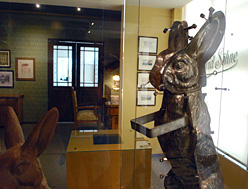 In 1933, when the National Socialists came to power, the company was renamed as Mignon Chocolate Works for fear that the David name would be identified as Jewish and be boycotted. In 1943, during the Second World War as the import of cocoa stopped, the production of confections was discontinued, and the factory was converted to making aircraft parts for the Seibel company in Halle for the Seibel 202 sport plane and the Junkers 88, as a supplier for the Junkers factory in Dessau (see Junkers Museum Dessau).
In 1933, when the National Socialists came to power, the company was renamed as Mignon Chocolate Works for fear that the David name would be identified as Jewish and be boycotted. In 1943, during the Second World War as the import of cocoa stopped, the production of confections was discontinued, and the factory was converted to making aircraft parts for the Seibel company in Halle for the Seibel 202 sport plane and the Junkers 88, as a supplier for the Junkers factory in Dessau (see Junkers Museum Dessau).
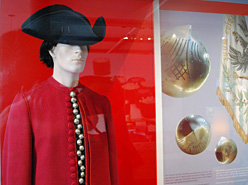 In 1950, the factory was revamped to make chocolates again and company was converted to a socialist state public combine. The name was changed to Halloren in 1952 with the introduction of the signature chocolate ball, modelled on the Mozart Ball of Salzburg. The name was inspired by the historic brotherhood of salt workers (Salzsieder-Fraternity) who built Halle’s prominence in the middle ages, and the kuglen got their name from the round silver buttons of the Salt Workers Brotherhood traditional uniforms still worn at festivals.
In 1950, the factory was revamped to make chocolates again and company was converted to a socialist state public combine. The name was changed to Halloren in 1952 with the introduction of the signature chocolate ball, modelled on the Mozart Ball of Salzburg. The name was inspired by the historic brotherhood of salt workers (Salzsieder-Fraternity) who built Halle’s prominence in the middle ages, and the kuglen got their name from the round silver buttons of the Salt Workers Brotherhood traditional uniforms still worn at festivals.
In recent years, the company has acquired and joined other chocolate makers, like the Confiserie Dreher of Munich, founded in 1880, the makers of the Mozart chocolates. They continue to grow, recently acquiring a majority stake in the Belgian chocolatier Bouchard. In 2014, the company entered into a partnership with the "Charlie Investors” making them a real “Charlie” and the chocolate factory, I kid you not. Though, the investors are basically a Dutch venture capital fund and are not offering any golden tickets.
Chocolate Museum
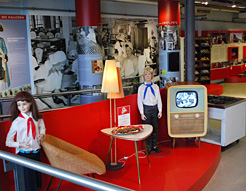 The Halloren Chocolate Factory Museum – Adventure World was first opened in 2002. It covers three floors of exhibits present the history of chocolate from the discovery of the cocoa bean in jungles of South America to the making of sweet chocolate. The Halloren factory building was built in 1896 and still used for production, as well as for factory store sales and the Chocolate Museum. Exhibits cover the different eras of the company’s journey, but the most notable is the famous Chocolate Room, not so unlike the fictional world of Willie Wonka, a room where almost everything is made of chocolate.
The Halloren Chocolate Factory Museum – Adventure World was first opened in 2002. It covers three floors of exhibits present the history of chocolate from the discovery of the cocoa bean in jungles of South America to the making of sweet chocolate. The Halloren factory building was built in 1896 and still used for production, as well as for factory store sales and the Chocolate Museum. Exhibits cover the different eras of the company’s journey, but the most notable is the famous Chocolate Room, not so unlike the fictional world of Willie Wonka, a room where almost everything is made of chocolate.
Chocolate Room
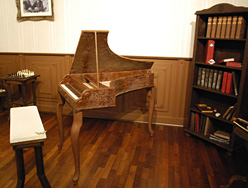 When the Halloran museum opened it was the first room in the world made of chocolate, representing the Biedermeier furnishings of the company’s founders, including Mr. David sitting at his desk. Almost all the furniture, dishes, cutlery, and vases and even the portrait cameo paintings and candles are made of chocolate and marzipan. In April of 2017 the chocolate room was renovated by master confection chef and chocolate artist Gerhard Petzl, creating new objects (exact copies of wooden originals) and replacements for earlier ones.
When the Halloran museum opened it was the first room in the world made of chocolate, representing the Biedermeier furnishings of the company’s founders, including Mr. David sitting at his desk. Almost all the furniture, dishes, cutlery, and vases and even the portrait cameo paintings and candles are made of chocolate and marzipan. In April of 2017 the chocolate room was renovated by master confection chef and chocolate artist Gerhard Petzl, creating new objects (exact copies of wooden originals) and replacements for earlier ones.
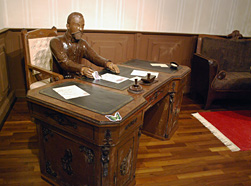 The inventory on display includes the desk, a chair and life-size sculpture of David, a couch, oval coffee table, a cake, glasses, plates and fruit platter, a fireplace with fire, picture frames with edible art, a pen, pen holder and edible documents, a bookshelf, and a one pet cat resting on a pillow. The company owner sitting at his desk surrounded by his working documents, represents the golden era of the years of the Mignon brand. The solid objects in chocolate took Gerhard and a chocolatier team from the factory’s “Pralineum” around 5,000 hours to create with 1,450 kg of chocolate used.
The inventory on display includes the desk, a chair and life-size sculpture of David, a couch, oval coffee table, a cake, glasses, plates and fruit platter, a fireplace with fire, picture frames with edible art, a pen, pen holder and edible documents, a bookshelf, and a one pet cat resting on a pillow. The company owner sitting at his desk surrounded by his working documents, represents the golden era of the years of the Mignon brand. The solid objects in chocolate took Gerhard and a chocolatier team from the factory’s “Pralineum” around 5,000 hours to create with 1,450 kg of chocolate used.
Pralineum
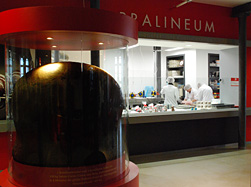 At the end of the museum tour is the Pralineum where you can view living chocolate workers making Pralines, the current varieties of chocolates the company makes, and taste a few, while in the shadow of the world’s largest ball of chocolate and marzipan, created by the Halloren master chocolatier Torsten Riel for a commemoration ceremony. It’s preserved in a large glass case near other sculptured items, including a chocolate version of the city’s statue of home-town composer Georg Frederick Handel, the Handel House and other edible architecture.
At the end of the museum tour is the Pralineum where you can view living chocolate workers making Pralines, the current varieties of chocolates the company makes, and taste a few, while in the shadow of the world’s largest ball of chocolate and marzipan, created by the Halloren master chocolatier Torsten Riel for a commemoration ceremony. It’s preserved in a large glass case near other sculptured items, including a chocolate version of the city’s statue of home-town composer Georg Frederick Handel, the Handel House and other edible architecture.
Visiting the Halloren Chocolate Museum Adventure World
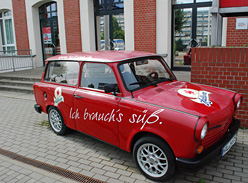 Open hours are 9 am to 6:30 pm Monday to Friday, 10 am to 5 pm Saturday and 11 am to 5 pm Sunday and Holidays. Admission for adults is €6. Children from 3 to 12 is €4, and a Family Ticket (2 adults and up to 3 children) is €16. Guided tours (in German) are offered at 5 pm Monday, Wednesday and Friday, and 1 pm Saturday and Sunday, with tours at noon Monday to Friday in summer (end of June to early August) for € 8 adults and € 4.50 per child up to 12.
Open hours are 9 am to 6:30 pm Monday to Friday, 10 am to 5 pm Saturday and 11 am to 5 pm Sunday and Holidays. Admission for adults is €6. Children from 3 to 12 is €4, and a Family Ticket (2 adults and up to 3 children) is €16. Guided tours (in German) are offered at 5 pm Monday, Wednesday and Friday, and 1 pm Saturday and Sunday, with tours at noon Monday to Friday in summer (end of June to early August) for € 8 adults and € 4.50 per child up to 12.
The Halloren factory and museum can be reached by public transport, Tram number 7 from the market place/central station in the direction Büschdorf to the Fiete-Schulze-Strasse stop. By car on Delitzscherstrasse between the Halle-Ost exit of the A 14 motorway and the Hbf main train station. Look for the red East German “Trabi” Trabant car which served as candy delivery vehicle in the GDR days parked in front. © Bargain Travel Europe
Find best hotel and vacation deals in Halle (Saale) on TripAdvisor
Web Info
Halloren
These articles are copyrighted and the sole property of Bargain Travel Europe and WLPV, LLC. and may not be copied or reprinted without permission.
See Also:
MARKET CHURCH HALLE - MARTIN LUTHER DEATH MASK
BAUHAUS & MASTER HOUSES DESSAU

